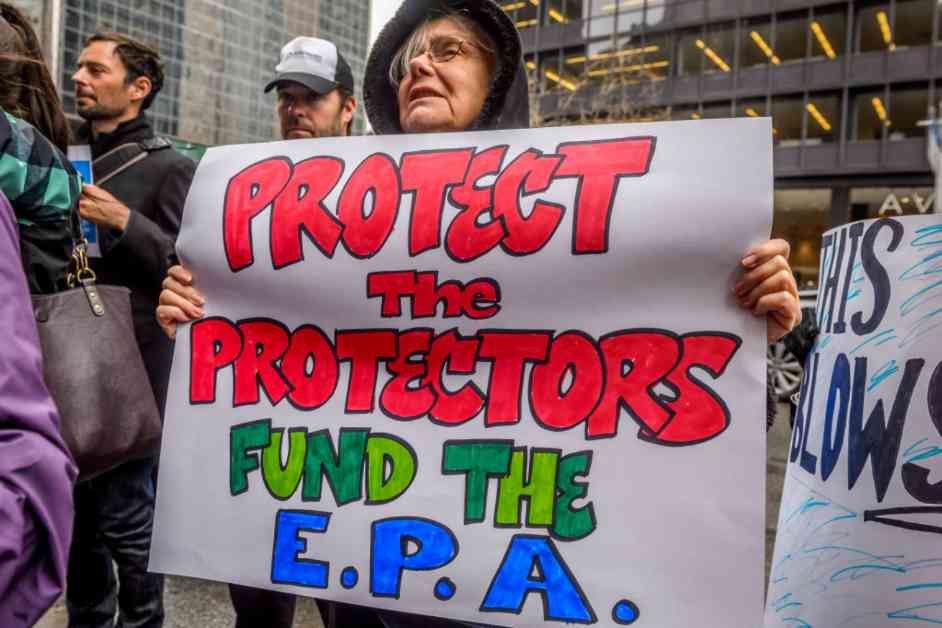As Amanda Cronin savored her slice of chocolate cake, little did she know that her journey at the Environmental Protection Agency (EPA) would be a rollercoaster ride of hope, uncertainty, and ultimately, disappointment. Fresh out of a nine-month job search in environmental advocacy, the 25-year-old New Yorker found herself at the EPA’s Office of Environmental Justice and External Civil Rights (OEJECR) in Washington, D.C. in May 2023. The Biden Administration was then leading a groundbreaking effort to promote environmental justice across the nation, infusing the office with the fervor of a start-up company.
With enthusiasm and dedication, Cronin dived headfirst into her role, facilitating the EPA’s collaborations with tribes and local advocacy groups. She spearheaded webinars that empowered residents from Arizona to Alabama to access federal grants to combat pollution in their communities. The sense of purpose and camaraderie fueled her passion for the cause. However, the winds of change began to blow as the 2024 presidential election approached, casting a shadow of uncertainty over her EPA tenure.
On February 6, Cronin and 167 of her colleagues were abruptly placed on indefinite leave, signaling a grim turn of events. A week later, 388 staffers in their first year at the agency faced termination, marking the beginning of a tumultuous chapter. Cronin, like many others, navigated the sudden upheaval by immersing herself in scuba diving, yoga classes, and a delicate balance of staying informed without succumbing to despair.
In a cruel twist of fate, the EPA dealt another blow to Cronin and her peers on a fateful Tuesday, announcing the immediate dissolution of all environmental justice offices and positions. The move, mandated by President Trump’s executive order, aimed to dismantle programs perceived as radical and wasteful, despite their alignment with the administration’s purported goal of uplifting marginalized communities. Cronin, echoing the sentiments of her colleagues, lamented the irony of the decision that jeopardized the progress made towards ensuring fair treatment for all.
The roots of the EPA’s environmental justice initiatives run deep, dating back to the establishment of OEJECR in 1992 under President George H.W. Bush’s administration. The office, initially housed within the Office of Policy, underwent a transformative evolution in 2022 under former EPA Administrator Michael Regan. Elevating OEJECR to a national program office underscored the agency’s commitment to safeguarding every American’s right to a healthy environment, a mission echoed by environmental justice advocates like Margot Brown.
Margot Brown, the senior vice president of environmental justice and equity at the Environmental Defense Fund, hailed the strategic shift as pivotal in prioritizing clean air, water, and land for all citizens. The move empowered OEJECR to engage directly with the EPA’s top leadership, ensuring that environmental justice remained a central focus of agency decisions. The office’s strategic initiatives resonated with dedicated staff members like Tracy, whose passion for environmental justice fueled her work in managing cooperative agreements.
Despite the abrupt termination that Tracy faced under the Trump administration, her commitment to upholding environmental justice principles remained unwavering. Collaborating with disadvantaged communities to implement transformative programs, Tracy and her colleagues strived to rectify past injustices and forge new partnerships based on trust and respect. Tracy’s reflections shed light on the stark contrast between the EPA’s grassroots efforts and the sweeping regulatory changes announced by the administration.
The announcement of the EPA’s decision to shutter environmental justice offices reverberated across the nation, coinciding with a wave of deregulatory actions aimed at dismantling key environmental protections. As the Trump administration moved to roll back regulations governing industries like petroleum refineries and oil and gas, millions of Americans faced increased exposure to toxic pollutants, placing vulnerable communities at heightened risk.
In a glimmer of hope amidst the chaos, two federal judges intervened, ruling the administration’s firing sprees unlawful and ordering the reinstatement of thousands of federal employees. Tracy received a reprieve in the form of an email rescinding her termination, offering a temporary respite from the uncertainty looming over her future. As she grappled with the repercussions of the EPA’s decision, Tracy raised poignant questions about the fate of communities adjacent to toxic sites, highlighting the enduring impact of environmental injustices on vulnerable populations.
The fate of environmental justice initiatives hangs in the balance as the EPA grapples with conflicting mandates and political pressures. Tracy’s resilience and dedication underscore the profound implications of these decisions on communities at the frontlines of environmental degradation. As advocates like Tracy continue to navigate the shifting landscape of environmental policy, the fight for equitable access to clean air, water, and land remains an urgent imperative in safeguarding the well-being of all Americans.














